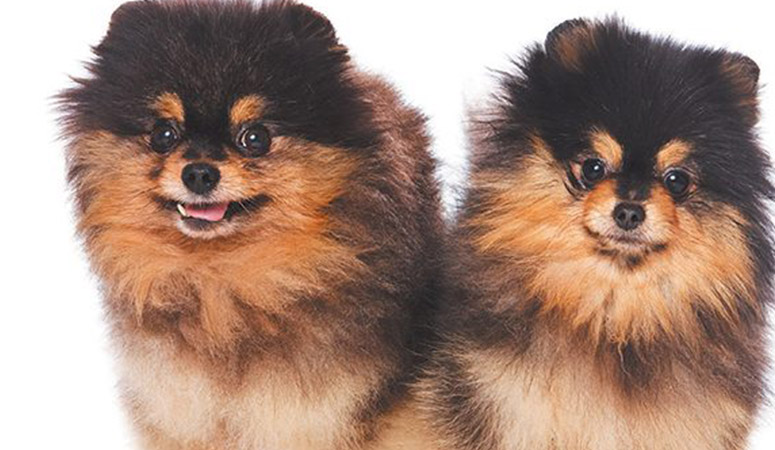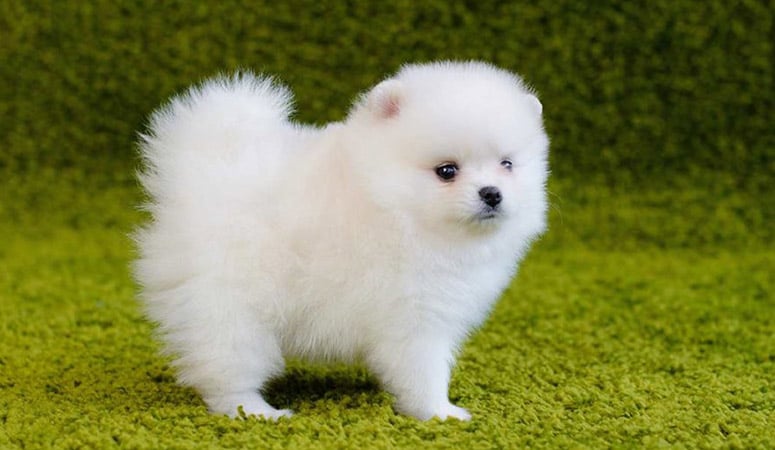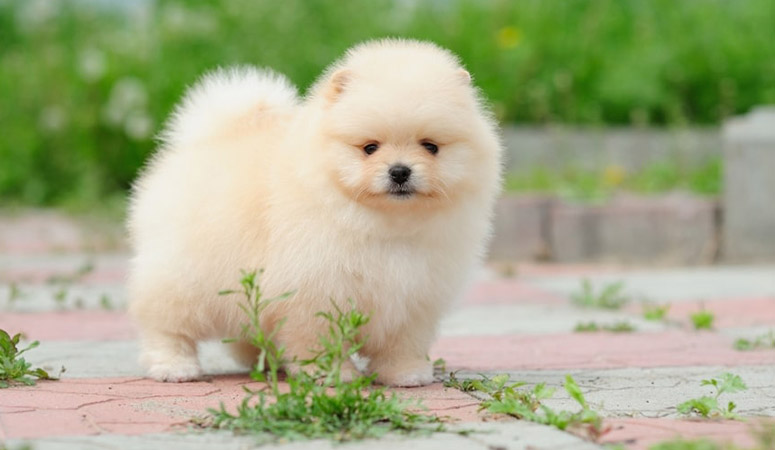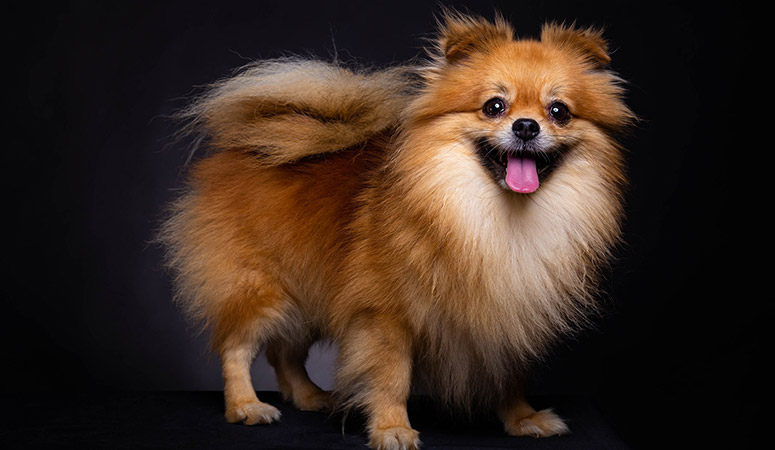Pomeranian
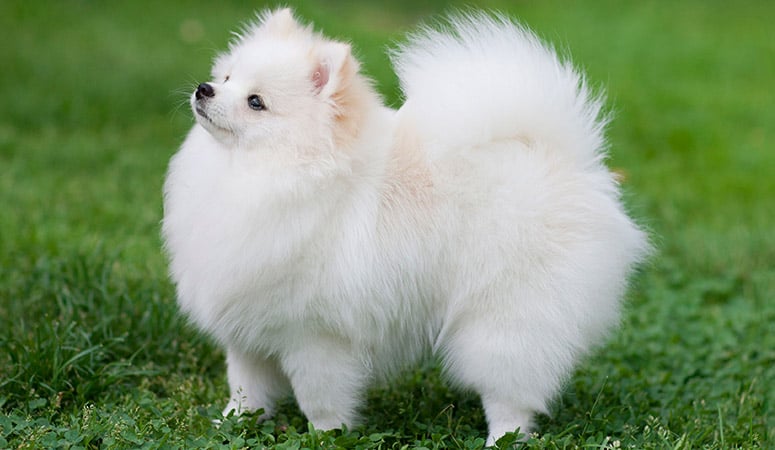
Tiny in size, originally popular in Queen Victoria period, the Pomeranian dog is characterized by its foxy faces and vivacious personality. This dog is the smallest of the spitz-type breeds and has a long and interesting history. Today, Poms are one of the most popular toy breeds all over the world.
| Other Names | Dwarf Spitz, Pom, Toy German Spitz, Zwergspitz |
| Color | Black, Blue, Brown, Gray, Orange, Red, White |
| Height | Males: 7-12 inches. Females: 7-12 inches. |
| Weight | Males: 4-7 pounds. Females: 3-6 pounds. |
| Life Span | 12-16 years |
| Personality | Inquisitive, Bold, Lively |
| Exercise | Regular Exercise |
| Origin |
| Popularity | #24 |
| Groom Needs | 2-3 Times a Week |
| Kids Friendly | Yes with supervision |
| Dog Friendly | Yes with supervision |
| Watch Dog | |
| Family Dog | |
| Litter Size | 2-4 |
Pomeranian Pictures
Pomeranian Video
Introduction
Dogs have always been man’s friend, but a Pomeranian sticks closer than a brother and makes you laugh like you were not to. Their abundant well-textured coat, combined with the fringe of fur around their neck, these little dogs evince incredible boldness. Although the earliest breeds were usually white, Pomeranians have evolved a dynamic variety that comes in almost any color.
Lively companions at homes, exercise buddies in the yard, and yet dedicated watchdogs, Pomeranians get to adapt to roles easily due to their unmatched trainability. Being small dogs, a standard Pom (a nickname) stands at about 6-9 inches high from shoulder to paw, without a significant difference between both sexes. They weigh somewhere around 3-8 pounds at the weighing scales. The Pomeranian breed is ranked 23rd most popular breed by the American Kennel Club. They are sturdy and healthy companion dogs, often living to a full age of about 13 or 16 years before they die.
Living with Pomeranian
The Pomeranian has a fluffy double coat that requires regular maintenance. The owner needs to brush and comb your dog at least twice weekly with a wire slicker brush and metal comb. It can help distribute the skin’s natural oils, keep the skin and coat healthy, and prevent hair mats or tangles. Besides, the owner needs to make sure the brush and comb all the way down to the skin to remove all the shedding undercoat.
If the owner couldn’t help your dog groom at home, it is highly suggested that taking your dog to a professional groomer to do a full groom every four to six weeks, including bath, trim, brushing, ears, nails, and anal glands.
Poms are prone to dental problems, a regular teeth brush is recommended to prevent periodontal disease.
Pomeranians are energetic dogs and they can get the most of their exercise requirement when playing indoors and with short daily walks or playtimes. Pomeranians are very active indoors and are good choices for apartment dwellers and people without a fenced yard.
The owner needs to keep a close eye on your dog when outside, Pomeranians are easy to escape through small crevices or gaps in fencing or climbing over short fencing. As its tiny size, the Pomeranian could be mistaken for rabbits or squirrels by large, predatory birds such as hawks and owls. So, it is very important to keep your Pomeranian undercover or stay with him all the time.
Besides, Pomeranians like to play and can become bored easily, so the owner should give your dog many toys and make sure there is always something new.
Generally, it is recommended to feed a Pomeranian with a quarter to a half-cup high-quality dry dog food every day, divided into two meals. More importantly, the food amount should depend on the dog’s weight, size, age, and activity level. There should be fresh and clean water at all times.
Some dogs are easy to get overweight, so you need to watch their calorie consumption and weight level all the time. Treats may be an important aid in training, but excessive intake can lead to obesity. Also, owners need to distinguish which human food is safe for dogs and which are not. If you have any problems with your dog’s weight or diet, just consult from your veterinarian.
Pomeranians are prone to the following health conditions: trachea collapse, dental concerns and tooth loss, eye concerns, deafness, cryptorchidism, hypothyroidism, dislocated kneecaps (luxating patella)…
Major concerns: patellar luxation
Minor concerns: hypoglycemia, open fontanel, PRA, entropion, shoulder luxation,
Occasionally seen: PDA, tracheal collapse, Legg-Perthes
Suggested tests:
Cardiac Exam
Patella Evaluation
Ophthalmologist Evaluation
Total Annual Cost: $2418
Cost is estimated for the first year and may vary depending on many factors, such as dog food, health care, leash, collar, licensing, possible fencing, crates, training and obedience classes, dog-walking, grooming, treats, toys, flea, tick, and heart-worm meds, microchips, etc.
The Pomeranians may be willful or manipulative, although intelligent. They can learn basic commands with ease, but it can be more difficult when making them cooperate. They should be trained to walk on a leash early on and taught to come when called. Housebreaking may be a challenge, so consistency and patience are very important in the training process. The owner needs to keep your dog from jumping on and off couches or beds because they can injure joints or even break a bone.
Poms are alert and highly intelligent, they love and can perform well in canine activities like agility, rally, and obedience, or working as a therapy dog.
History
The name of the breed was borrowed from geographical Pomerania, situated between Germany and Poland along the Baltic sea. This trumped up the erroneous theory that the breed originated in this region. Instead, recent documented studies show that the breed developed, rather than originated, in Pomerania. The ancestors of the Pomeranian dogs are believed to have originated in the Arctic regions. They were large working dogs of the Wolf Spitz-type (commonly called Spitz) and the Pomeranian dog is believed to have originated directly from the German Spitz.
Little was known about the dog for ages, only for isolated documents here and there, the oldest probably dating back to the 1760s. Hence, it is unclear where the chain of modern Pomeranians began. It wasn’t until their introduction to Great Britain that information about this breed of dogs began to come to light.
The subsequent part of the history of this breed began in association with the British Royal House. Queen Charlotte was reputed to have imported Pomeranians to England and had played a pivotal role in influencing the development of the breed. Years later, her granddaughter, Queen Victoria took to the same breed of dogs of especially smaller sizes, even breeding them in large kennels.
Although the breed had become popular in 18th century England, the first club was founded in 1891, after which the standard for their breeding was drafted. The American Kennel Club recognized the Pomeranian breed at the turn of the 20th century, although it registered a pioneer in 1898.
Helpful Information
Breed Club: AMERICAN POMERANIAN CLUB, INC.
Breed Club Link: http://www.americanpomeranianclub.org/
Breed Club Rescue:
Breed Club Rescue Link: http://www.americanpomeranianclub.org/rescue_contacts.htm

